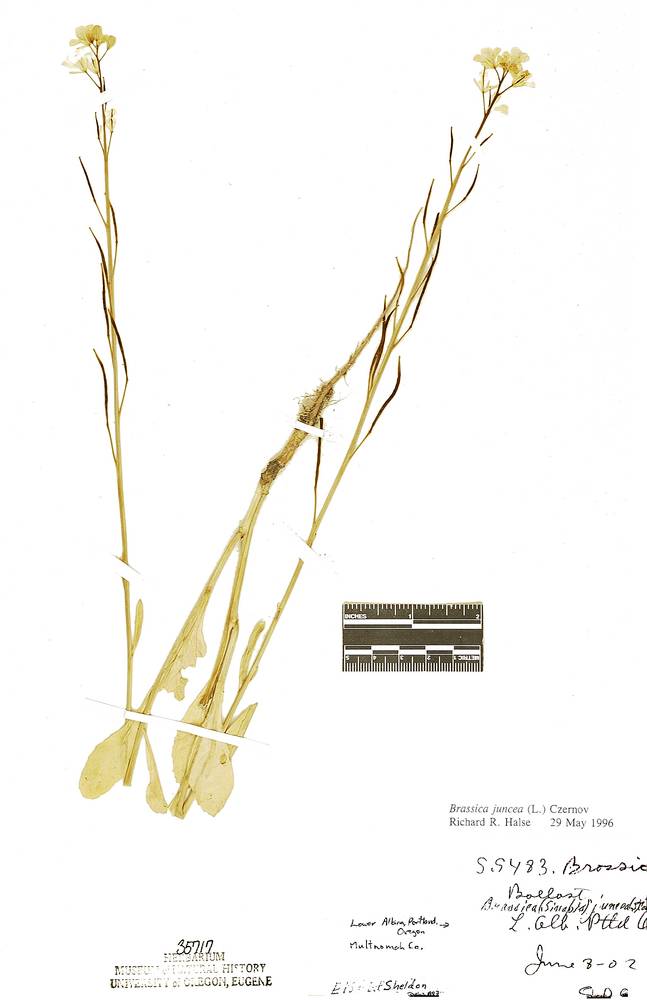
Plants annual, pubescent or rarely glabrous, glaucous or not.
Stems erect, (2)3–10(18) dm, branched above.
Basal leaves and lowermost cauline (4)6–30(80) × 1.5–15(28) cm, margins lyrate-pinnatifid to pinnatisect, incised, dentate, or entire, terminal lobes larger than 1–3 lateral lobes on each side; long-petiolate.
Upper cauline leaves oblanceolate, oblong, lanceolate, or linear, to 10 cm, bases not auriculate; petiolate or subsessile.
Inflorescences fruiting pedicels straight, divaricate, (5)8–15(20) mm.
Flowers sepals spreading, oblong, (3.5)4–6(7) mm; petals ovate to obovate, (6.5)8–11(13) × 5–7.5 mm, yellow, claws 3–6 mm; filaments 4–7 mm, lateral curved at base.
Fruits divaricate to ascending, not appressed to rachis, terete or slightly flattened, (2)3–5(6) cm × 3–4(5) mm; valvular segments (1.5)2–4.5 cm, 6–15(20)-seeded per locule; valves with prominent midveins, slightly torulose; terminal segments conical, (4)5–10(15) mm, seedless; sessile.
Seeds 1–1.7 mm in diameter.
2n=36.
Roadsides, disturbed areas, cultivated and abandoned fields. Flowering Apr–Sep. 0–300 m. BR, WV. CA, ID, NV, WA; worldwide. Exotic.
Brassica juncea is an allotetraploid derived from B. nigra (2n=16) and B. rapa (2n=20).
as described under Brassica juncea
Annuals; (± glaucous), ± glabrous. Stems branched distally, 2-10 dm. Basal leaves (early deciduous); petiole (1-)2-8(-15) cm; blade pinnatifid to pinnately lobed, (4-)6-30(-80) cm × 15-150(-280) mm, lobes 1-3 each side. Cauline leaves usually shortly petiolate, rarely sessile; blade (oblong or lanceolate, reduced in size distally), base tapered or cuneate, not auriculate or amplexicaul, (margins dentate to lobed). Racemes not paniculately branched. Fruiting pedicels spreading to divaricately ascending, (slender), (5-)10-15(-20) mm. Flowers: sepals (3.5-)4-6(-7) × 1-1.7 mm; petals pale yellow, ovate to obovate, (7-)9-13 × 5-7.5 mm, claw 3-6 mm, apex rounded or emarginate; filaments 4-7 mm; anthers 1.5-2 mm. Fruits (sessile); spreading to divaricately ascending to nearly erect (not appressed to rachis), torulose, subcylindrical or somewhat flattened, (2-)3-5(-6) cm × 2-5 mm; valvular segment with 6-15(-20) seeds per locule, (1.5-)2-4.5 cm, terminal segment seedless (conic), (4-)5-10(-15) mm, (tapering to slender style). Seeds brown or yellow, 1.2-2 mm diam.; seed coat finely reticulate-alveolate, not mucilaginous when wetted. 2n = 36.Flowering May-Sep. Roadsides, disturbed areas, waste places, cultivated and abandoned fields, garden escape from cultivation; 0-3000 m; introduced; Alta., B.C., Man., N.B., Nfld. and Labr., N.W.T., N.S., Ont., P.E.I., Que., Sask.; Ala., Alaska, Ariz., Ark., Calif., Colo., Conn., Del., D.C., Fla., Ga., Idaho, Ill., Ind., Iowa, Kans., Ky., La., Maine, Md., Mass., Mich., Minn., Miss., Mo., Mont., Nebr., Nev., N.H., N.J., N.Mex., N.Y., N.C., N.Dak., Ohio, Okla., Oreg., Pa., R.I., S.C., S.Dak., Tenn., Tex., Utah, Vt., Va., Wash., W.Va., Wis., Wyo.; Europe; Asia; Africa; introduced also in Mexico, West Indies, Central America, South America, Australia.Brassica juncea is cultivated in North America primarily as a vegetable and condiment, and is currently being developed as an oilseed crop in western Canada. Its greatest diversity of forms occurs in Asia, where the species is widely cultivated as a vegetable and as an oilseed crop (I. A. Al-Shehbaz 1985). Two main variants are distinguished on the basis of seed color: oriental mustard is yellow-seeded, and brown or Indian mustard is brown-seeded. The species is an allotetraploid derived from hybridization between B. nigra (n = 8) and B. rapa (n = 10). Its center of origin is uncertain but is most likely the Middle East, with possibly independent multiple origins within overlapping ranges of the putative parental taxa (S. I. Warwick and A. Francis 1994). Specimens from Delaware, District of Columbia, and Mississippi have not been observed, but are still listed here.